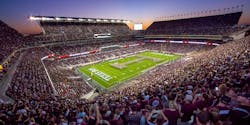Passive optical LAN’s scalability meets Texas A&M Kyle Field’s future needs
By John Hoover, Association for Passive Optical LAN, Tellabs
The sports world has seen a shift in recent years, in the way fans want to experience live sporting events. It was not too long ago when a fan would plan on disconnecting from the world for three hours in order to watch a sporting event in a stadium and cheer with thousands of other fans. Bringing a portable radio to listen to the broadcast of the game was the extent of the external connection that fans expected. In many cases, it was the only way to see a given sporting event. The advent of sports-focused cable channels, high-definition TV, and mobile streaming now give fans more ways than ever to see a game without going to the stadium. The new challenge for sports teams is how to keep fans coming to the stadium, when so many other options exist. One university tackled this challenge head-on, with the goal to create a stadium experience that keeps fans coming back.
Texas A&M University (TAMU), located in College Station, Texas, USA, is home to more than 59,000 students each year. Located on a 5200-acre campus 90 miles northwest of Houston, TAMU is known for excellence in both its academic and athletic programs.
Originally built in 1927, Kyle Field is the home of the TAMU Aggies football team. A renovation was kicked off in 2013 that would expand the seating capacity from 82,600 to 102,733, making it the fourth-largest football stadium in the country. Known as “Home of the 12th Man” for its loud and large fan base that gives TAMU a great home-field advantage, the vision was not only to expand the seating capacity of the stadium, but also to make the stadium experience a technological wonder as well. This multi-year project would see half of the stadium razed and rebuilt during the 2013-2014 offseason and the other side demolished and reconstructed during the 2014-2015 offseason.
Planning for technology's key role
TAMU leadership understood the role that technology would play in creating a great fan experience at the new Kyle Field. They also knew the network infrastructure delivering that technology had to be rock solid as well as scalable for delivery of even more demanding technologies in the future. TAMU wanted to take their fan experience to the next level by leveraging technology to create a stadium experience that students and fans would enjoy just as much as the game itself. This included new multimedia displays, both in the stadium and in the concourses, connected menu boards and operations in the concession areas, and excellent connectivity for both cellular and WiFi-connected devices in and around the stadium.
In order to accomplish these goals, TAMU leadership knew they needed a stable network foundation that would enable all of those other services to be successful. If a traditional local area network (LAN) technology was used, this would mean a multitude of network closets (with power, cooling, and security challenges), layers of Ethernet switches to distribute connectivity, and miles of cabling. Separately, a distributed antenna system (DAS) for cellular coverage would be required, with its own cabling infrastructure and power requirements. The cost and complexity of this would have a negative impact on both the timeline and the budget.
In order to meet the demands of all these new services without the cost and complexity of legacy technologies, TAMU chose a converged infrastructure, with optical fiber cabling and power delivery to the edge, for both LAN and DAS needs. This was an innovative choice that leverage passive optical LAN (POL). The POL provided the ideal architecture to build a network capable of handling the immense task of connecting all the new services, including security cameras throughout the stadium, the ticketing system scanning 105,000 tickets per game, more than 115 menu boards at the concession stands with coordinated menu displays, and the point-of-sale registers at those concession stands to feed the hungry fans. In addition, the network has to provide high-speed IPTV streaming to more than 1,000 video screens in the suites and common areas, connect hundreds of IP phones, and provide WiFi throughout the stadium to more than 1,200 wireless access points.
The advantage of choosing POL? The number of network closets throughout the stadium was reduced by more than 50%, the amount of copper cabling was reduced by more than 90%, and the cabling management requirements were reduced with the combination of POL, WiFi and DAS connectivity over a common optical fiber infrastructure. Additionally, this converged network of POL, WiFi, and DAS gains synergy with common 48V powering to the edge devices of the network.
All of this came at a cost that was significantly less than a traditional stadium network infrastructure.
Put to the test
With a stadium nearly 30% larger than the average National Football league stadium, and a young fan base that has grown up with social media and mobile connectivity, a powerful, high-performance network was required in order to deliver a great game-day experience. POL is the power behind this network. POL is the next-generation LAN infrastructure that built a sold foundation for the Kyle Field success. POL provides the bandwidth, reliability, security, and robust centralized management that networks demand in today’s always-connected environment.
The pressure was on to complete the installation of the Tellabs POL electronics in time for the opening game of the 2015 season. This would mark the completion of the stadium redevelopment, and the first chance for the fans to immerse themselves in the new fan experience that TAMU leadership had envisioned.
The Aggies hosted the Ball State Cardinals in their home opener. As more than 100,000 fans watched the game, they began to light up social media to share their excitement about streaming videos and watching instant replays on their phones. Twitter was ablaze with accolades for the new Kyle Field, and the POL, WiFi and DAS performance. The security team was monitoring the video feeds from the cameras around the stadium, ensuring a safe environment for the fans. The cashiers were serving up food with the new point-of-sale systems while customers kept up with the scores on the video boards in the concession areas.
Capacity headroom
During the last home game of the TAMU season, the POL network was monitored to see what the real bandwidth demands were. How far could 104,000 fans actually push the Kyle Field network?
That final 2015 season game at the newly refurbished Kyle Field was against Auburn University. The game started late in the afternoon. With 104,625 fans packing the stadium, rain was in the forecast. The passive optical LAN has three core switches (called optical line terminals, or OLTs) to handle all the online devices in the stadium.
As expected, data traffic on the network had a few noticeable spikes in traffic: right before kickoff, and at halftime. As is normal with most large venue networks, the asymmetric nature of social network traffic was apparent.
The busiest port on the OLTs saw a peak downstream utilization of 474 Mbits/sec at kickoff (i.e. 20% total downstream capacity utilization), while the peak upstream port maxed out at 46.6 Mbits/sec (i.e. a 3% total upstream capacity utilization), with other ports showing similar spikes. During the game, the system saw 27.65 terabytes of data downloaded at the PON port level, while 1.49 terabytes of data was uploaded.
With the busiest POL OLT port only reaching downstream capacity at 20% and total upstream capacity merely at 20%, this traffic demand was well within the system design, leading to the great experience that the fans bragged about on social media.
Traffic tapered off in the fourth quarter as the Aggies’ chance for victory began to slip away. The Aggies would close out that season with a record of 8 wins and 5 losses, but there is no question that the new Kyle Field stadium is a winner with fans.
The changing landscape of technology is presenting challenges for people who run large venues, such as Kyle Field. The convergence of new devices, such as security cameras and cash registers, as well as the connectivity demands of the clientele, demand a high-performance network that can meet these challenges. Passive optical LAN is perfectly suited to meet the demands of today’s large public venue network, and is scalable to meet the future needs as well.
John Hoover is a marketing director at Tellabs and board director of the Association for Passive Optical LAN. For the past 15 years he has influenced industry milestones such as early passive optical LAN deployments, video implementations, wireless and more recently enterprise passive optical LAN adoption.

